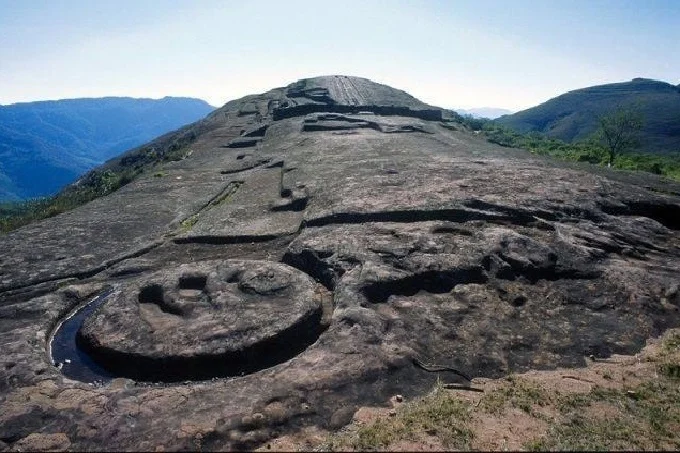The archaeological complex of El Fuerte de Samaypata only attracted the attention of scientists in the eighteenth century, but it was excavated and began to be studied almost two centuries later – at the beginning of the twentieth century.
El Fuerte de Samaypata was visited twice by the Swiss theorist, writer, and filmmaker Erich von Däniken. Erich von Däniken laid out the results of his research in his book “Celestial Teachers. The Cosmic Code of Antiquity”, which was released in 2005. In his book, Erich von Daniken described in detail this mysterious complex and made his assumptions about their possible purpose.
The top of El Fuerte hill is presented in the form of a pyramid of regular shape. It gives the impression that it was built by human hands rather than created by nature. From the bottom and up to the top, there are two perfectly straight troughs, half a meter wide and twenty-seven meters long. Externally, the troughs are very reminiscent of an inclined launcher pointing into the sky. To get the latest stories, install our app here.
There are zigzag lines between the troughs and along the edges along their entire length that form a series of rhombic. Nothing is known about the purpose of these lines. At the mountain’s highest point, namely at the top of the alleged “launcher” is a platform.
This platform has a rounded shape, with triangles and rectangles hollowed out in the rock itself, on the outer radii of the platform. Due to the fact that this rounded platform adjoins directly to the edge of the “launcher” on the artificially leveled top of El Fuerte hill, the Swiss theorist has the idea of a catapult.
How does he explain it? Perhaps the people who created this mechanism fixed something like a glider or a balloon at the bottom of the troughs, which as a result, moved upwards on rails that were laid in the troughs. Well, at the top of the circular platform were rubber ropes, they went down, and there were attached to the flying apparatus itself. It must be said that even for the Inca ancestors, such construction should not have been very difficult.
There is only one legend about Mount El Fuerte with its round platforms and grooves. This legend says that from Mount El Fuerte, the gods returned to heaven. There is an opinion that the Indians tried to imitate the gods. To get the latest stories, install our app here.
That is why they built a copy of the flying machine covered with a thin layer of gold alloy. This alloy was obtained by the Incas on the very grooves and round pads that are on top of El Fuerte. When sacred holidays came, the Incas catapulted their flying machine made of gold directly into the sky, intending to send their greetings to the gods in this way.
Generally speaking, Inca rulers considered themselves “sons of the sun”.
In his research, Erich von Daniken describes one unusual ancient vase that comes from El Salvador. This vase is an artifact of Mayan culture. What makes it so remarkable? The fact is that this vase depicts a reclining man with a large belly, on the back of which is attached a unit strongly resembling a radar.
The Egyptian artifact, together with numerous other examples from different parts of the world, is another proof that our ancestors could not understand the purpose of various advanced technologies and tried to imitate aliens, creating imitations of their devices. So, the Swiss researcher Erich von Daniken came to the conclusion that the creators of the so-called “launcher” on El Fuerte hill “sent” people to the heavens using a catapult, hoping that the gods would accept these living projectiles. To get the latest stories, install our app here.
